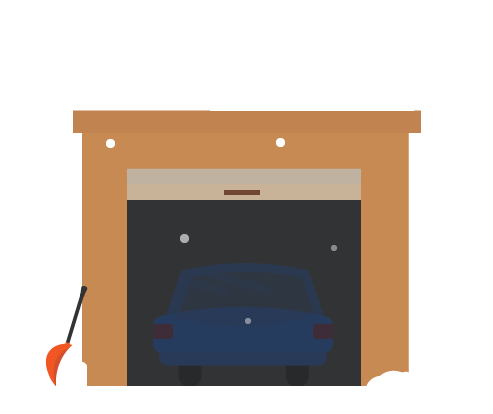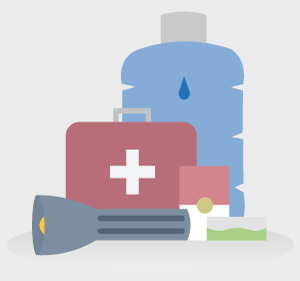- Home Page
- Guides
- Winter Preparedness Guide
- Your Car
Winter Car Preparedness: How to Prepare Your Car for a Winter Storm
Winter roads can be dangerous, and having to drive somewhere during a winter storm can be a real burden. Make sure your car is prepared for any winter storm or winter driving by servicing your car, driving safely, and packing a winter car emergency kit.

Winter Checklist for Vehicles: How to Winterize Your Car
There are a few things you can do to get your car ready for an impending winter season. Winterizing your car can take time and money, so plan ahead accordingly with this winter checklist for vehicles.
- Check your tire tread. When getting your car ready for winter, be sure to inspect your tires for tread wear and rotate them during every oil change. To check your tire’s tread, use the “Penny Test”. You do this by taking a penny and placing it in the tread groove of your tire. Place the penny with Lincoln’s head facing you, and stick the penny in the tread so that the top of Lincoln’s head is no longer visible. If his entire head is visible while in the groove, it’s time to replace your tires.
- Fill up your tires. Low air pressure in your tires can be potentially dangerous on winter roads. Take your car to a mechanic to check your tire pressure and fill your tires if necessary. If you have prior knowledge on checking tire pressure, you can easily do it yourself at a free tire air pump found at your local gas station or car shop.
- Consider snow tires. Switching to snow tires, especially in northern countries or mountain areas that get heavy snow on rough terrain, can help driving on snowy and slippery roads.
Tip: snow tires make your MPG (miles per gallon) lower, so only put on snow tires during harsh winter months - Change your oil and antifreeze. Regular maintenance to your vehicle can only but help to prevent any car troubles during months involving winter driving.
- Fix your heater. Short drives aren’t too burdensome when you don’t have heat in your car, but consider what would happen if you were stuck in your car for an extended period of time-- all the while not having heat. Having a working heater can help prevent daily discomfort, but it can also be a great preventative measure.
- Inspect your battery. You r vehicle’s battery capacity lessens in cold weather. Be sure your car is prepared for the winter and have a professional inspect your battery’s fluid and cables.
Explore Home Energy Solutions With Constellation
In addition to your car, find peace of mind that your home is prepared for winter too. View Home Energy Solutions with Constellation.
Preparing for Winter Driving
If the area where you live isn’t accustomed to driving in the winter, snowfall may mean sheer panic on the roadways. Keep a level head, and adhere to these tips on winter driving safety:
How to drive in the snow
- Account for extra travel time. Driving in winter conditions will most likely take more time than usual, due to slower traffic along the way, snow plows and salt sprayers, or unplowed roads. Prepare for winter driving and give yourself plenty of time to reach your destination.
- Remove snow or ice from your car. Use an ice scraper or a makeshift ice-scraper (a spatula or CD works fine!) to clear the windows. If the snow accumulation is heavy on the top of the vehicle, be sure to scrape/push the majority of it off. This prevents any large chunks of icy snow from flying off while you’re driving and hurting another driver.
- Drive slower than usual. Following the speed limit is a good rule to live by, and it’s important to follow it to keep all drivers safe on the road (We’re looking at you, lead-footers!). If you’re uncertain about the conditions of the road, go around 10 mph under the speed limit, to be safe. The faster your car is going, the less reaction time you’ll have to handle your car skidding on ice.
- Keep your accelerating and decelerating slow. Try not to rev-up or slam on the brakes, for both actions could launch your car into a tailspin.
- Always wear your seatbelt. The truth is that most winter storm-related deaths involve a vehicle. Wearing a seatbelt reduces your chance of injury in a car crash by more than 45%, so be sure to buckle up!
- Don’t use cruise control. Winter driving requires you to be in complete control of your car at all times, and it is important since a patch of slippery ice can pop up on the road at any time. For this reason, using cruise control in wintry conditions makes roads that much more dangerous.
- Watch out for black ice. Thin, transparent ice that blends in with the color of the pavement, commonly known as black ice, is especially dangerous because it’s hard to spot, and you don’t know you’ve come up on it until you’ve slid over it. The best way to handle black ice is to let up on both the gas and brakes, and keep the wheel straight. If you start to fishtail (when the back of your car starts to spin), gently turn the wheel to the direction the spin is going until you’ve stopped or have regained traction.
How to get your car out of a snow bank
Use these tips to help get out of a snowy situation, or help others that are stuck!
Check to see if your exhaust pipe is clogged. This should always be one of the first items on your checklist with getting your car out of snow. If your car’s exhaust pipe, usually located in the external rear of the car, is clogged, carbon monoxide may seep into the car’s interior and cause carbon monoxide poisoning-- a potentially deadly incident. If it is clogged or blocked, scoop out snow and clear the area of the tailpipe.
Dig, dig, dig. If you have a snow shovel in your winter car emergency kit, kick up your heels and start digging! Dig out as much as you can around your vehicle: near the tires, underneath the car, in the front, in the back, etc. The more you preliminarily dig out snow, the less you’ll have to deal with slipping on when you try to move your car.
Tip: pay attention to what your body is telling you, and avoid overexertion. If you’re feeling too cold or fatigued, take a break and sit in your warm car or a warm shelter.Avoid revving. It may seem logical to press on the gas hard to get out of a situation where your car is stuck, but in cases of snow, it’s about the worst thing you can do. When your wheels spin fast without getting you anywhere they create friction and heat. That heat melts the snow underneath your tire, and turns it to ice almost immediately, which makes driving out of the snow much harder.
- Rock-n-roll. We’re not talking about blaring AC/DC through your radio (though if that helps you get the strength to push your car out, blare it loud!). Rocking your car back and forth can dislodge your vehicle from any compact snow dip that’s keeping your car from moving. This can be done with extra help from people, or just by yourself. If you have extra people to help, have them stand outside of your car, and have them rock the vehicle back and forth from the rear of the vehicle. Sit in the driver's seat and plan to accelerate to gain traction to move forward. If you’re by yourself and need to get your car out of a snow bank, using drive and reverse functions can cause the same effect, and get your car moving forward and out of the snow.
What to Do if You’re Stranded in Your Car During a Blizzard
In the case of being stuck in a car during a snowstorm, follow these tips to ensure your safety, provided by the The Weather Channel:
- Call for help immediately! Some cell phones turn off if the outside temperature is too cold, even if they are fully charged. Once you realize you’re stuck, call someone first for help. This way, they’ll know exactly where you are, and can help to save you if you’re not able to get out.
- Determine if you can leave. If you’re in an area where you can safely reach a point of shelter or civilization, decide if you want to leave your car to search for warmth and safety. When in doubt, don’t risk it.
- Prevent carbon monoxide poisoning. Exit the car to check if your exhaust tailpipe is being blocked or clogged by snow. Clear out the area or pipe if necessary.
- Dig yourself out, if possible. If you think that you’re able to get your car out easily, follow the steps listed in the above section to remove your car from the snow bank. If not, stay in your car and wait for help.
- Make yourself visible. Tie a neon or brightly colored ribbon around your car’s antenna to signal your location to help teams.
- Run car intermittently. To prevent hypothermia and other winter-related illnesses, turn on your car every now and then to heat up the vehicle’s cabin area. Since you don’t know how long you’ll be stranded, use gas sparingly and only turn your car on when necessary.
Tip: check the car’s tailpipe for clogging each time you turn your car on. - Ration food and water. If you have a supply of food and water, eat and drink sparingly, just in case you’re stuck longer than anticipated.
Tip: in severe cases, you can use snow as a water source, but always be sure to melt it down into water before drinking it. Eating snow can lower your body temperature and heighten your risk of hypothermia.
Things to Put In Your Car for Winter
Keep yourself and your family safe by adequately stocking your car with what you’ll need in the case of car trouble during a winter storm. Use the following checklists to prepare your car for all winter weather emergencies, whether it be stuck in a snowbank, driving in the icy snow, or being stranded in a snowstorm.
Checklist: winter emergency kit for car trouble:
- Emergency flares
- Flashlight
- Extra batteries
- Hand crank or battery-powered radio
- Ice scraper for windshield and windows
- Shovel
- Jumper cables
- Neon flag or ribbon
- Roadmap
- Chain or sturdy rope for towing
- Tire chains
- Rock salt to melt ice, sand, and/or kitty litter for traction in snow
- Reflectors
Checklist: winter survival kit for your car:
- Warm blankets
- Extra hats and gloves
- Water and non-perishable food
- Cell phone charger and/or power brick
- Extra medications

Explore Winter Preparedness Guides for Your Home and Small Business: Winter Preparedness
Learn More About the States We Service
Interested in finding an energy plan that fits your budget? Explore electricity or natural gas plans in your area: